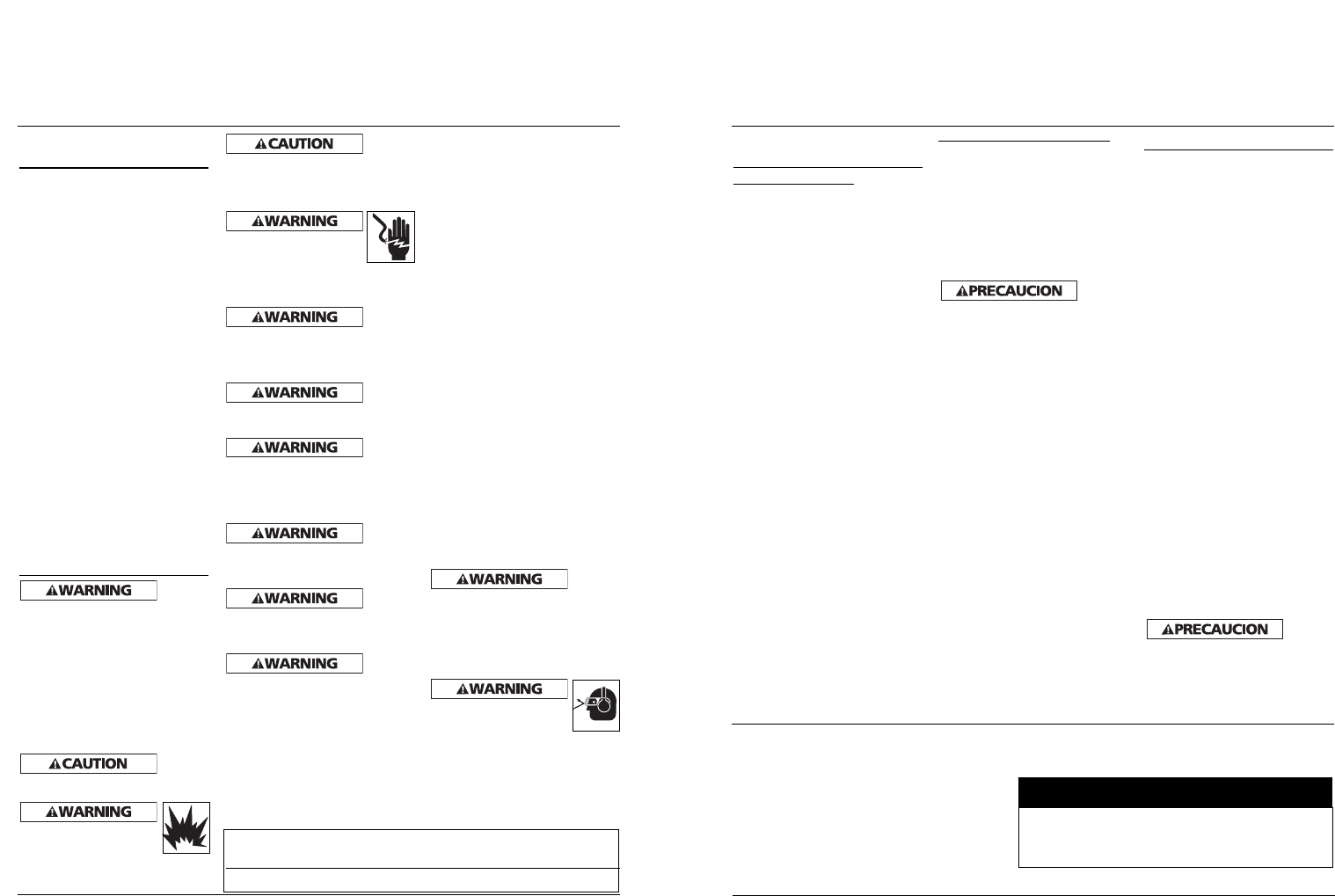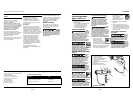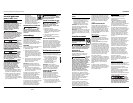
PERFORACIONES EN MAMPOSTERÍA
Para MAMPOSTERÍA, como ladrillo,
cemento, bloque de escorias, etc., use
brocas con punta de carburo aptas para
taladrar con percusión y asegúrese de
que la broca tenga filo.
Asegúrese de que esté seleccionado el
modo de percusión. Use una fuerza
constante y firme sobre la herramienta
para perforar más eficazmente. Un flujo
suave y parejo de polvo indica la
velocidad de perforación adecuada.
El hecho
de
presionar en exceso laherramienta no
acelerará la perforación. De hecho, esta
presión excesiva solamente servirá
para dañar la punta de la broca,
disminuir el rendimiento de la
herramienta yacortar la vida útil de la
herramienta.
SI EL TALADRO SE DETIENE, por lo
general es porque se está
sobrecargando o no se está usando
bien. SUELTE EL INTERRUPTOR
INMEDIATAMENTE, retire la broca
del trabajo y determine la causa de
la detención. NO APRIETE EL
INTERRUPTOR PARA ENCENDER
Y APAGAR INTENTANDO REANUDAR
LA PERFORACIÓN; ESTO PUEDE DAÑAR
EL TALADRO.
Para minimizar las detenciones
o quebrar el material, disminuya la
presión sobre el taladro y suelte la
broca a través de la última parte
fraccional del orificio.
Mantenga el motor en funcionamiento
al retirar la broca de un orificio
perforado. Esto ayudará a evitar
los atascos.
Funcionamiento
(Continuación)
PERFORACIÓN EN METAL
Para METAL, utilice la configuración
“DRILL” (taladrar) y brocas helicoidales
de acero o brocas de campana.
USE ÚNICAMENTE en la función
“DRILL” (taladrar). Comience a perforar
a baja velocidad y vaya aumentando
hasta llegar a la potencia máxima
mientras aplica presión firme a la
herramienta. Un flujo suave y parejo
de astillas de metal indica la velocidad
de perforación adecuada. Use un
lubricante para cortes cuando perfore
metales. Las excepciones son hierro
fundido y bronce que deben perforarse
en seco. Los lubricantes para corte que
funcionan mejor son el aceite de corte
sulfurizado o la grasa de cerdo; la grasa
de tocino también servirá para esto.
Use brocas helicoidales de alta
velocidad o brocas de campana.
Use unpunzón para iniciar el orificio.
Lubrique las brocas con aceite para
cortar cuando taladre en hierro
o acero. Use líquido refrigerante
cuando taladre en metales no ferrosos
como cobre, bronce o aluminio. Apoye
el material para evitar el atascamiento
y la distorsión en el punto de ruptura.
Para evitar que la broca se deslice al
iniciar un orificio, haga una muesca con
un punzón y un martillo en el punto
que quiere taladrar. Coloque la punta
de la broca en la muesca y comience
a perforar.
Use un lubricante para cortes cuando
perfore metales. Las excepciones son
hierro y bronce que deben perforarse
en seco.
Mantenimiento
El servicio de la herramienta debe ser
realizado sólo por personal de
reparaciones calificado. El servicio
o mantenimiento realizado por
personas no calificadas puede provocar
riesgo de lesiones.
Limpieza
Limpie el polvo y los desechos de
los orificios y contactos eléctricos,
soplando con aire comprimido.
Mantenga los mangos de las
herramientas limpios, secos y libres
de aceite o grasa. Use únicamente un
jabón suave y un paño húmedo para
limpiar la herramienta, evitando todos
los contactos eléctricos.
Ciertos agentes de limpieza y solventes
son nocivos para los plásticos y otras
piezas aisladas. Algunos de éstos
incluyen gasolina, aguarrás, solvente
para laca, solvente de pintura,
solventes de limpieza con cloro,
amoníaco y detergentes de uso
doméstico que contengan amoníaco.
Nunca use solventes inflamables ni
combustibles cerca de las herramientas.
LUBRICACIÓN
Para su seguridad y protección
eléctrica continuas, la lubricación
y elservicio de esta herramienta
deberán ser realizados ÚNICAMENTE
por un CENTRO DE SERVICIO
AUTORIZADO DE CAMPBELL HAUSFELD.
SERVICIO TÉCNICO
Para obtener información con relación
al funcionamiento o reparación de
este producto, sírvase llamar al
1-800-424-8936.
El
servicio
de la herramienta debe serrealizado
sólo por personal de reparaciones
calificado. El servicio omantenimiento
realizado por personas no calificadas
puede provocar riesgo de lesiones.
DG190600CK
19 Sp
Para Ordenar Repuestos o Asistencia Técnica, Llame al Teléfono 1-800-424-8936
Sirvase darnos la siguiente información:
- Número del modelo
- Código impreso
- Descripción y número del repuesto según la lista de repuestos
Número del
Descripción Repuesto
Dirija toda la correspondencia a:
Campbell Hausfeld
Attn: Customer Service
100 Production Drive
Harrison, OH 45030 U.S.A.
Lista de Repuestos
Llave del portabrocas de 13mm (1/2") DG026800AV
Guía de profundidad de metal DG026900AV
Mango lateral ajustable DG027000AV
General Safety
Information (Cont’d.)
3. Do not wear loose fitting clothing,
scarves, or neck ties in work area.
Loose clothing may become caught
in moving parts and result in serious
personal injury.
4. Do not wear jewelry when
operating any tool. Jewelry may
become caught in moving parts and
result in serious personal injury.
5. Always use attachments designed
for use with this tool. Do not use
damaged or worn attachments.
6. Never trigger the tool when not
applied to a work object.
Attachments must be securely
attached. Loose attachments can
cause serious injury.
7. Never point a tool at oneself or any
other person. Serious injury could
occur.
8. Use steady, even pressure when
using tool. Do not force. Too much
pressure can cause drill to break or
overheat.
9. Keep all nuts, bolts and screws tight
and ensure equipment is in safe
working condition.
10.Do not put hands near or under
moving parts.
General Power Tool
Safety Warnings
Read all
safety
warnings and all instructions. Failure
to follow the warnings and instruc-
tions may result in electric shock, fire
and/or serious injury.
Save all warnings and instructions for
future reference.
The term "power tool" in the warnings
refers to your mains-operated (corded)
power tool or battery-operated (cord-
less) power tool.
WORK AREA SAFETY
Keep
work
area clean and well lit. Cluttered or
dark areas invite accidents.
Do not operate power tools
in explosive atmospheres,
such as in the presence of
flammable liquids, gases or dust.
Power tools create sparks which may
ignite the dust or fumes.
Keep
children
and bystanders away while operating a
power tool. Distractions can cause you
to lose control.
ELECTRICAL SAFETY
Power tool plugs must match
the outlet. Never modify the
plug in any way. Do not use
any adapter plugs with earthed
(grounded) power tools. Unmodified
plugs and matching outlets will reduce
risk of electric shock.
Avoid
body
contact with earthed or grounded sur-
faces, such as pipes, radiators, ranges
and refrigerators. There is an increased
risk of electric shock if your body is
earthed or grounded.
Do not
expose
power tools to rain or wet conditions.
Water entering a power tool will
increase the risk of electric shock.
Do not
abuse
the cord. Never use the cord for carry-
ing, pulling or unplugging the power
tool. Keep cord away from heat, oil,
sharp edges or moving parts. Damaged
or entangled cords increase the risk of
electric shock.
When
operat-
ing a power tool outdoors, use an
extension cord suitable for outdoor
use. Use of a cord suitable for outdoor
use reduces the risk of electric shock.
If operat-
ing a
power tool in a damp location is
unavoidable, use a residual current
device (GFCI) protected supply. Use of a
GFCI reduces the risk of electric shock.
Hold
power
tools by insulated gripping surfaces
when performing an operation where
the cutting tool may contact hidden
wiring or its own cord. Contact with a
“live” wire will make exposed metal
parts of the tool “live” and shock the
operator.
Double insulated tools are equiped with
a polarized plug (one plug blade is wider
that the other). This plug will fit in a
polarized outlet only one way. If the plug
does not fit fully into the outlet, turn the
plug over and insert into plug again.
1. Make sure cord is located so that it
will not be stepped on, tripped
over, or otherwise subjected to
damage or stress.
2. Do not use an extension cord unless
absolutely necessary. Use of
improper extension cord could
result in a risk of fire and electric
shock.
If an extension cord must be used,
make sure:
• That the pins on plug of
extension cord are the same
number, size and shape as those
of plug.
• That the extension cord is
properly wired and in good
electrical condition.
• If an extension cord is to be used
outdoors it must be marked with
the suffix “W-A” or “W”
following the cord type
designation to indicate it is
acceptable for outdoor use. For
example – SJTW-A
3. Do not expose to rain, snow or
frost.
4. Do not operate tool with damaged
cord or plug.
• Have a damaged or worn power
cord and/or strain relief replaced
immediately.
• Do not attempt to repair power
cord.
PERSONAL SAFETY
Stay
alert,
watch what you are doing and use
common sense when operating a
power tool. Do not use a power tool
while you are tired or under the influ-
ence of drugs, alcohol or medication. A
moment of inattention while operating
power tools may result in serious per-
sonal injury.
Use personal protective
equipment. Always wear eye
protection. Protective equip-
ment such as dust mask, non-skid safe-
ty shoes, hard hat, or hearing protec-
tion used for appropriate conditions
will reduce personal injuries.
2
Operating Instructions and Parts Manual
www.chpower.com
Length of Cord in Feet 25 50 100 150
AWG Size of Cord 18 18 18 16
Minimum Wire Size (AWG) of Extension Cord












